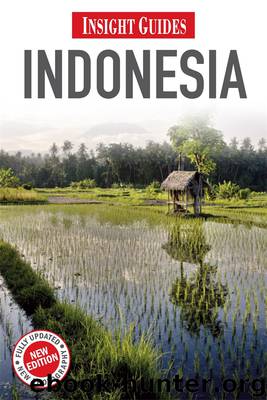Insight Guides: Indonesia by Insight Guides

Author:Insight Guides
Language: eng
Format: epub
Tags: Travel, Indonesia
Publisher: APA
Published: 2012-07-19T04:00:00+00:00
Sandstone carving at Pura Beji temple, Sangsit.
Corrie Wingate/Apa Publications
Pengastulan-Seririt to Singajara
Back to the north coast highway, from Pengastulan-Seririt heading east there are pockets of resorts away from the main highway on the north shore dedicated to healing, meditation and yoga. Set almost alongside these is an astonishing number of private villas, many of them for rent. The road is lined with vineyards that feed Bali’s blossoming wine industry.
Further east is a 12km (7.5-mile) long stretch of black-sand beach encompassing Pemaron, Tukad Mungga, Anturan, Kalibukbuk, Kalisasem and Temukus villages, collectively called Lovina ¢ [map]. In the 1970s and 1980s, Lovina was the escape of choice for crowd-weary former Kuta enthusiasts, but as development continued it was transformed from quiet fishing village to a Kuta clone, minus the bars. After a slump, when it became threadbare and musty, it has taken on new life; modern resorts and renovations abound, but it is no longer the quiet haven it once was. The diving has never been spectacular here – the biggest attraction is early-morning dolphin-watching boat trips – and today’s travellers use it primarily as a base for exploring North Bali and the highlands with sand and surf on the side rather than the other way around.
The next stop is Singaraja, formerly Bali’s capital city. In contrast to the south, citrus fruit orchards, tomatoes, vanilla, coffee, cacao, grapes and cloves replace the familiar rice paddies. About 10km (6 miles) south of Singaraja, the Air Terjun Gitgit (daily during daylight hours; charge) waterfalls flow vigorously during the rainy season. The soft pink sandstone that gives North Bali’s temples their distinctive character was quarried near here.
Singaraja ∞ [map] has a cosmopolitan flavour, derived from centuries as an important trading port until 1953 when shipping was moved to the more convenient Benoa Harbour in the south. Bali’s second-largest city after Denpasar, its population comprises Buddhists, Javanese, Arabs and Chinese. The Gedong Kirtya historical library (Mon–Thur 8am–4pm, Fri–Sat 8am–noon; charge) on Jalan Veteran is a repository of old books and Balinese manuscripts established by the Dutch in 1928. It has a fine collection of lontar manuscripts – books inscribed on palm-leaf strips and preserved between two pieces of wood or bamboo. The ancient volumes cover subjects such as literature, mythology, history and religion.
There are some Dutch-era buildings hidden behind clutter on Jalan Ahmad Yani, and across a small bridge, a gift from the queen of Holland, is the old harbour. Just over the bridge is Ling Gwan Kion Chinese temple, an interesting structure dating back to 1873, with beautifully manicured gardens. Someone will be happy to show you around and tell you about the historic accoutrements that remain here. Some of the old waterfront buildings are being restored and the restaurants on stilts make an excellent lunch stop, serving grilled fish amid cool ocean breezes. From Singaraja, a major north–south highway goes to Denpasar.
Singaraja to Air Sanih
East from Singaraja, the land becomes increasingly dry as the road winds around the east coast, eventually passing an area devastated by the 1963 Gunung Agung eruption north of Tulamben.
Download
This site does not store any files on its server. We only index and link to content provided by other sites. Please contact the content providers to delete copyright contents if any and email us, we'll remove relevant links or contents immediately.
China Rich Girlfriend by Kwan Kevin(4298)
The Silk Roads by Peter Frankopan(4275)
Annapurna by Maurice Herzog(3304)
Full Circle by Michael Palin(3274)
Hot Thai Kitchen by Pailin Chongchitnant(3221)
Okonomiyaki: Japanese Comfort Food by Saito Yoshio(2629)
The Ogre by Doug Scott(2509)
City of Djinns: a year in Delhi by William Dalrymple(2438)
Photographic Guide to the Birds of Indonesia by Strange Morten;(2412)
Vietnam, Cambodia, Laos & Northern Thailand by Lonely Planet(2321)
Tokyo by Rob Goss(2295)
Tokyo Geek's Guide: Manga, Anime, Gaming, Cosplay, Toys, Idols & More - The Ultimate Guide to Japan's Otaku Culture by Simone Gianni(2244)
Everest the Cruel Way by Joe Tasker(2135)
Discover China Travel Guide by Lonely Planet(2121)
Iranian Rappers And Persian Porn by Maslin Jamie(2102)
China (Lonely Planet, 11th Edition)(2037)
Lonely Planet China(2032)
China Travel Guide by Lonely Planet(1995)
Top 10 Dubai and Abu Dhabi by DK Travel(1994)
